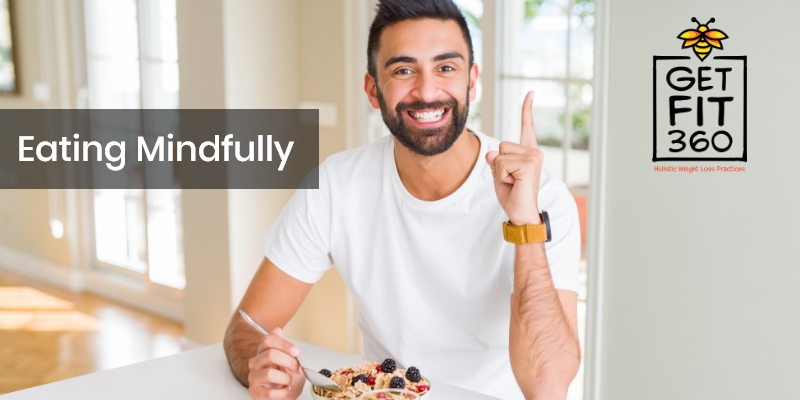Eating Mindfully
Eating as mindfully as we do in a mindfulness course is not realistic for many of us, especially with families, jobs, and the myriad distractions around us. This is not to mention that our friends, family and colleagues might not have the patience to eat with us as we take five minutes with each bite. So have some self-compassion, and consider formal mindful eating on retreat and special occasions, as well as informal mindful eating in your daily life.
Guidelines for Staying Mindful While Eating
Here are six simple guidelines to keep in mind to discern between mindless and (more) mindful eating, and bring our bodies and minds back together.
1. Eat Slow and Steady To Avoid Overeating
Eating rapidly past full and ignoring your body’s signals vs slowing down and eating and stopping when your body says it’s full. Slowing down is one of the best ways we can get our mind and body to communicate what we really need for nutrition. The body actually sends its satiation signal about 20 minutes after the brain, which is why we often unconsciously overeat.
2. Listen to the Signals From Your Body
Know your body’s personal hunger signals and respond in the right way. Often we listen first to our minds, but like many mindfulness practices, we might discover more wisdom by tuning into our bodies first. Rather than just eating when we get emotional signals, which may be different for each of us, be they stress, sadness, frustration, loneliness or even just boredom, we can listen to our bodies.
3. Share and Connect Mindfully
Eating alone and randomly vs Eating with others at set times and places. Another way that we eat mindlessly is by wandering around looking through cabinets, eating at random times and places, rather than just thinking proactively about our meals and snacks. This slows us down for one thing but prevents us from developing healthy environmental cues about what and how much to eat, and wires our brains for new
cues for eating that are not always ideal. It also helps to eat with others, not only are you sharing and getting some healthy connection, but you also slow down and can enjoy the food and conversation more, and we take our cues from our dinner partner, not over or undereating out of emotion.
4. Nutritional Value Vs Comfort Factor, Balance your Eating Needs and Wants
Eating foods that are emotionally comforting vs eating foods that are nutritionally healthy. This is another tricky balance, and ideally, we can find nourishing foods that are also satisfying and comforting. As we practice eating healthier and a greater variety of foods, we are less inclined to binge on our comfort foods and more inclined to enjoy healthy foods, ultimately finding many foods mentally and physically satisfying as opposed to just a few.
5. Respect The Source of Food
Considering where food comes from vs thinking of food as an end product. Many of us don’t even consider where a meal comes from beyond the supermarket packaging. This is a loss because eating offers an incredible opportunity to connect us more deeply to the natural world, the elements and to each other.
6. Focussing on Only Eating
Multitasking and eating is a recipe for not being able to listen deeply to our body’s needs and wants. We’ve all had the experience of going to the movies with our bag full of popcorn, and before the coming attractions are over, we are asking who ate all of our popcorn. When we are distracted, it becomes harder to listen to our body’s signals about food and other needs. With your next meal, try single-tasking and just
eating, with no screens or distractions besides enjoying the company you are sharing a meal and conversation with.
So while formal mindful eating practices may be what we think of when we look back on a mindfulness course or retreat we attended, the reality is that we do live and eat, in the real world which is a busy place. But we can take the insights gained from our formal practice-slowing down, listening to our bodies, doing one thing at a time, making even small rituals, and considering all that went into our meal on a more regular basis and bringing more informal mindfulness to our daily meals. If you want to know more meet with a mindfulness coach at a renowned health clinic.



